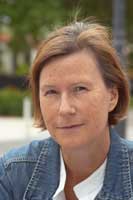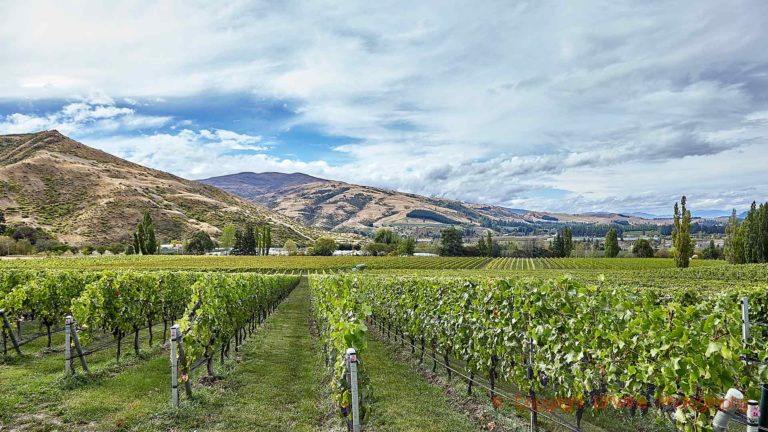In Champagne, you often classify producers as either “houses”, or “independent growers”. The houses are big and often rather anonymous companies owning little or no vineyards, buying grapes from small growers. The “independent producers” are smaller family-owned wineries that own their own vineyards and make wine from grapes they have grown. Champagne Duval-Leroy is somewhere in between. They are considered as a “house” since they don’t own all the vineyards they make wine from but they are family owned. A little while back, they launched their latest edition of their exclusive rosé champagne, Femme De Champagne Rosé De Saignée 2008. We have tasted it, as well as a few others of their top champagnes, and talked to the owner Carol Duval-Leroy.
Before I dive into their newly launched rosé, let me give you some more background on Champagne Duval-Leroy. It is one of the few houses that is still family-owned and family-run. For many years it has been managed by Carole Duval-Leroy. In 1991 she suddenly found herself at the helm of the company when her husband Jean Charles Duval-Leroy tragically died at the age of only 39. In the hands of Carole Duval-Leroy the house has become one of the most respected of the smaller houses. More recently, the day-to-day-operation of Champagne Duval Leroy is more and more in the hands of her children Julien, Charles, and Louis.
This is a longer version of an article published on Forbes.com.
Today, Champagne Duval-Leroy makes around 1.5 million bottles. They have a relatively modest (in number of cuvées) range of champagnes, some ten different cuvées, currently divided into “classic”, with a brut and another brut specifically labelled as organic, “prestige”, with a rosé and one called MOF (“Meilleur ouvrier de France”), two vineyard selections, Clos des Bouvier and Parcel Petit Meslier, and finally their top flagship wines that go under the label “Femme de Champagne” and are usually vintage champagnes, a brut and a rosé, today’s subject.
The house is located Vertus in the Côte des Blancs but have vineyards or source grapes both from Côte des Blancs and from Montagne de Reims. They control some 200 hectares of own vineyards and supplement that with bought-in grapes.
Femme de Champagne
The first vintage of their prestige cuvée Femme de Champagne was 1990. Initially, it was a white vintage champagne, but now there is also Femme de Champagne Brut (without vintage) and, of course, Femme de Champagne Rosé. “Femme” has become one of Champagne’s well-known and sought-after prestige cuvées. The base wine always gets some oak ageing, how much varies. Chardonnay dominates (except for the rosé) and is blended with a certain amount of pinot noir; how much depends on the year. At Duval-Leroy, the ageing on the lees is always long: 4 years at least for the non-vintage champagnes and ten years minimum for the different Femme de Champagne.
The house speciality is chardonnay, but on this day, the protagonist was a 100% pinot noir, Femme de Champagne Rosé de Saignée 2008, bottled in the unique and elegant bottle that has become a hallmark of the Femme series of champagnes. “It’s a complicated bottle shape, but we wanted it; we thought it was beautiful,” recalls Carol Duval-Leroy.
The complexity of champagne comes partly from extended ageing on the lees, after the second fermentation in bottle. In June of last year, Champagne Duval-Leroy launched its Femme Rosé de Saignée 2008 which means that it has spent just over 15 years in the cellars and is now ready to be enjoyed. During the launch in Paris, I chatted with Carol Duval-Leroy, her son Julien and winemaker Sandrine Logette-Jardin.
Duval-Leroy is one of the few significant houses that does not belong to any corporate grouping. “We are proud to be independent; that’s how we want it,” says Carol Duval-Leroy, who has run the family-owned house since 1991. She is also proud that her three sons, Julien, Charles, and Louis, all work in the family business.
“I’m retired,” she says, but that should probably not be taken literally. I don’t think she’s the type that sits around doing nothing. For over 30 years, she has been responsible for the business, and it has been a dynamic time. She has brought Duval-Leroy to a position as one of the leading houses in Champagne. They now produce 1.5 million bottles of champagne every year. She has a keen sense of what is trending. She works with restaurants, star chefs and sommeliers to promote champagne as something to enjoy with a meal. She has even written a cookbook called Femme de Champagne with local recipes paired with appropriate champagnes. But this is more than just a collection of recipes. It is also a way for Carole to share some of her thoughts about the essence of champagne and to share her art de vivre with her readers and drinkers of her champagne.
“We want to make quality, even luxury”, she says but adds in the same breath that “champagne is not luxury; it is a pleasure”.
Sandrine Logette-Jardin is today the head winemaker of Champagne Duval-Leroy. She has been with the company since 1991, the same year as Carole too the helms of the company and has been head winemaker since 2005. She was, in fact, the first woman to become head winemaker in Champagne, a region not really known for its femininity. Together with Carole Duval-Leroy she has no doubt been one of the driving forces to bring the house to the position it has today.
At Sandrine’s disposal is a state-of-the-art facility, a beautiful oak barrel cellar, five 8,000-kilogram presses to handle the large harvest, and five additional press halls spread across the Champagne region to enable the grapes to be pressed as quickly as possible. Instead of transporting the grapes, the juice is transported from the vineyard press houses to the Vertus facility.
“We have to preserve the finesse and elegance of our champagne,” says Sandrine. “It is one of the challenges of climate change to preserve the fresh character of our champagne. We must adapt and maybe change some parameters.”
Working sustainably is essential to the whole team at Duval Leroy. They have installed solar panels that supply parts of the facility in Vertus with electricity and systems to collect rainwater. Duval-Leroy was the first champagne house to produce a certified organic cuvée.
The five Femme de Champagnes
While talking to Carole, her son Julien, and Sandrine, the winemaker, we tasted five wines from their Femme de Champagne range; their just-launched rosé, of course, but also some others to illustrate the depth and longevity of their prestige champagnes.
Femme de Champagne Rosé de Saignée 2008, Champagne Duval-Leroy
This rosé champagne is delicious, with a long, refreshing taste of strawberries and other red fruit. It is dry, complex, and distinguished, and if it were not for the bubbles, it could be mistaken for a light, aromatic, and outstanding pinot noir wine.
It is made from 100% pinot noir from grand cru vineyards in Bouzy. It has undergone a skin maceration of 18 hours and has a dosage (sugar addition) of 3 grams per litre. Only 3000 bottles have been produced, mainly sold to star restaurants.
Femme de Champagne Brut Grand Cru, Champagne Duval-Leroy
This non-vintage brut has a base wine from 2020. Chardonnay is complemented by 24% pinot noir. The wine has a lovely ripeness in the fruit with an unmistakable toasty character, a slight note of vanilla and hints of citrus. It has an excellent mouthfeel and ends with a long, relatively soft aftertaste.
Femme de Champagne 2008, Champagne Duval-Leroy
2008 is the latest vintage of Femme de Champagne, in its vintage version. This year, 7% of the wine was fermented and aged in oak barrels. Bottling after one year of ageing in barrel. It has great aroma, creamy mouthfeel, and exceptional freshness. Elegant with structure and length.
2008 was an exceptional year but not entirely straightforward, says Sandrine. The weather was mixed, and it was cold during the flowering. Then came a very hot July, a rainy August and a beautiful, sunny and warm September. The grapes had time to ripen properly. The result was a combination of excellent flavour concentration and great freshness.
Femme de Champagne 2002 Brut Nature, Champagne Duval-Leroy
The 2002 has a beautiful golden colour. This magnificent year was dry and warm, with a very sunny summer. “We got perfect maturity in the grapes,” says Sandrine, ” great concentration and high quality.” The grapes are 95% chardonnay and 5% pinot noir. 20% are aged in oak and on the lees for additional mouthfeel: intense aromas, great mouthfeel, with ripe stone fruits. The champagne is a “brut nature”; in 2002 there was no need to add any dosage.
Femme de Champagne 1996, Champagne Duval-Leroy
1996 was another challenging year. Bad weather during the flowering with millerandage (grapes that do not develop), but it is not only a negative thing, Sandrine believes, because it gives more concentration to the grapes that do develop. “We got both good sugar and acidity levels, so it was a successful year for us,” she says. The blend is 79% chardonnay vinified in oak barrels and 21% pinot noir. The dosage is 4 grams. The taste is remarkable and intense, with notes of hazelnut, white flowers, a hint of citrus peel and a full, creamy mouthfeel.
Femme de Champagne are impressive champagnes. But don’t hesitate to look for Duval-Leroy’s Fleur de Champagne. “It’s my everyday champagne,” says Carol.
We tasted the different cuvées of Femme de Champagne with food. And it showed precisely what Carol says: “A great champagne is, above all, a great wine that should be drunk with a good meal”. And I might add what Julien rightly pointed out: “Champagne should always be served in a wine glass” (not in a high and narrow “flute”).
Travel
The best way to discover the true soul of champagne and how it pairs with gastronomy is in Champagne. Explore champagne-and-food matching on a wine tour to Champagne with BKWine.
Travel to the world’s wine regions with the wine experts and the wine travel specialist.
Wine tours that give you insight. BKWine wine tours.
















